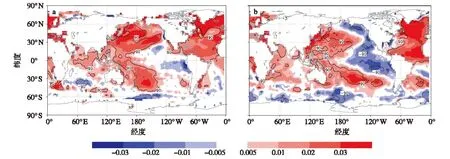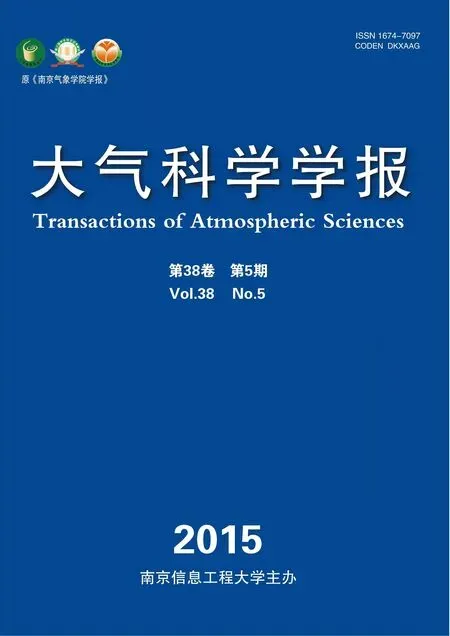1982—2009年冬夏两季热带季节内振荡的趋势特征
陶丽,吴盟盟,沈新勇,赵久伟
(1.气象灾害教育部重点实验室(南京信息工程大学),江苏 南京 210044;
2.南京信息工程大学 大气科学学院,江苏 南京 210044;3.南京信息工程大学 数学与统计学院,江苏 南京 210044)
1982—2009年冬夏两季热带季节内振荡的趋势特征
陶丽1,2,吴盟盟3,沈新勇1,2,赵久伟2
(1.气象灾害教育部重点实验室(南京信息工程大学),江苏 南京 210044;
2.南京信息工程大学 大气科学学院,江苏 南京 210044;3.南京信息工程大学 数学与统计学院,江苏 南京 210044)
摘要:采用1982—2009年美国国家海洋与大气管理局(National Oceanic and Atmospheric Administration,NOAA)逐日向外长波辐射(outgoing longwave radiation,OLR)资料,利用EOF方法,分析了20~70 d北半球夏季(6—9月)季节内振荡(boreal summer intraseasonal oscillation,BSISO)与冬季(12月—次年2月)季节内振荡(也称Madden-Julian Oscillation,MJO)不同的强度趋势。结果表明:BSISO指数有明显加强的趋势,而MJO指数的趋势则不明显。进一步利用频率—波数分析方法将季节内振荡(intraseasonal oscillation,ISO)分成西传和东传两部分。结果表明:东传的BSISO在其活动中心——热带印度洋地区有显著加强的趋势,而东传的MJO在其活动中心的趋势则不明显,仅在其活动中心西南部即热带印度洋西南部有减弱的趋势。为探究其原因,文章进一步分析了海表温度(sea surface temperature,SST)和纬向风垂直切变的趋势变化。结果表明:1982—2009年,西太平洋和印度洋SST无论冬夏均持续增暖,SST并不能解释冬夏两季ISO不同的趋势特征;而夏季热带印度洋地区对流层中低层东风垂直切变减弱,冬季海洋性大陆地区东风垂直切变增强。由此认为:热带印度洋东风垂直切变减弱有可能有利于东传的BSISO加强;而海洋性大陆地区东风垂直切变加强有可能削弱东传的MJO,但这种减弱效应被冬季海洋性大陆地区增强的上升运动产生的加强效应抵消,所以MJO的变化趋势并不显著。
关键词:热带季节内振荡;趋势;海面温度;东风垂直切变
中图分类号:
文章编号:1674-7097(2015)05-0641-09P434
文献标志码:码:A
doi:10.13878/j.cnki.dqkxxb.20130524001
Abstract:Based on the daily outgoing long-wave radiation(OLR) data of the National Oceanic and Atmospheric Administration(NOAA) from 1982 to 2009,by using EOF method,this paper investigated the intensity changes of the 20—70 d boreal summer(June-September;JJAS) intraseasonal oscillation(BSISO) and winter(December-next February;DJF) intraseasonal oscillation,also known as the Madden-Julian Oscillation(MJO).The results show that BSISO index has a significant intensifying trend during 1982—2009.On the other hand,little trend is found for boreal winter MJO index during this period.The wavenumber-frequency analysis method was applied to separate ISO(intraseasonal oscillation) into westward-propagated and eastward-propagated parts.For the eastward-propagated BSISO,a significant intensified trend is observed over tropical Indian Ocean or its action center.For the eastward-propagated MJO,there is no evident trend observed over its action center,except that a weakened trend is observed over southwestern tropical Indian Ocean(i.e.southwestern part of MJO action center).To gain insight into the different ISO characteristics,the tendencies of sea surface temperature(SST) and the vertical shear of zonal wind were analyzed.The results show that,in both seasons from 1982 to 2009,the global SST trends are similar,and thus they could not be used to explain the intensifying trend of BSISO.However,the lower-tropospheric easterly shear in boreal summer over tropical Indian Ocean has a decreasing trend,while the easterly vertical shear over the maritime continent is enhanced in winter.It is proposed that the reduced easterly vertical shear over tropical Indian Ocean favores the amplification of the eastward-propagated BSISO.The enhanced easterly vertical shear over the maritime continent might weakens the eastward-propagated MJO,but its impact is offset by the enhanced upward motion over the maritime continent.As a result,there is little trend for MJO in boreal winter.
收稿日期:2014-10-21;改回日期:2014-12-19
基金项目:国家重点基础研究发展计划(973计划)项目(2013CB430102);公益性行业(气象)科研专项(GYHY201506002);国家自然科学基金资助项目(41205082)
通信作者:陈耀登,博士,副教授,研究方向为气象资料同化,keyu@nuist.edu.cn.
Trend of tropical intraseasonal oscillations in summer and
winter during 1982—2009
TAO Li1,2,WU Meng-meng3,SHEN Xin-yong1,2,ZHAO Jiu-wei2
(1.Key Laboratory of Meteorological Disaster(NUIST),Ministry of Education,Nanjing 210044,China;
2.School of Atmospheric Sciences,NUIST,Nanjing 210044,China;
3.School of Mathematics and Statistics,NUIST,Nanjing 210044,China)
Key words:tropical intraseasonal oscillation;trend;SST;easterly vertical shear
0引言
热带大气季节内振荡(intraseasonal oscillation,ISO)是大尺度热带大气活动最显著的振荡信号之一,也被视为重要的大气环流系统之一。因其复杂性并与多种天气及气候现象相联系,ISO一直受到气象学者的高度重视。ISO主要分为两种:一种是以沿赤道东传为主的北半球冬季季节内振荡(MJO),另一种是以东传和北传为主的北半球夏季季节内振荡(BSISO)。ISO对亚澳夏季风的活跃和中断都有影响(Annamalai and Slingo,2001;蒋镇和朱伟军,2010;李崇银等,2003;蒋国荣等,2005;李丽萍和罗婷,2014;于群等,2014),且对西北太平洋和加勒比海热带气旋的生成(Liebmann et al.,1994;Ferreira et al.,1996;Maloney and Hartmann,2000;Hall et al.,2001;祝从文等,2004;陈光华和黄荣辉,2009;陶丽等,2012a,2012b),以及极端天气事件(如干旱、洪水)的发生起到一定的调制作用(Higgins et al.,2000)。它对亚澳季风区特别是东南亚地区的社会和经济活动具有深远的影响。
1资料和方法
采用1982—2009年美国国家海洋与大气管理局(NOAA)的逐日向外长波辐射(OLR;Liebmann and Smith,1996)资料(水平分辨率为2.5°×2.5°)、英国气象局Hadley气候预测和研究中心编辑的月平均海表面温度(SST)资料(水平分辨率1.0°×1.0°)以及欧洲中心(ECMWF)的ERA-interim再分析资料(水平分辨率1.5°×1.5°)。

本文还利用波数—频率分析方法(Hayashi,1982),将BSISO和MJO分为东传和西传两部分,并分析它们的趋势特征。
2结果分析
图1a、b分别为1982—2009年夏季(6—9月)OLR场的EOF第一模态和第二模态,其方差贡献率分别为15%和10%。由图1c可见,第二模态的时间序列(PC2)滞后于第一模态的时间序列(PC1)10 d左右(滞后相关系数图略),约为1/4个BSISO的活动周期,所以第二模态是第一模态东移后的结果。由图1a可见,与BSISO相关的对流活跃区(负值)出现在西北印度洋、孟加拉湾、南海和赤道西太平洋,形成了一个沿西北—东南走向的对流活跃带,而对流抑制区(正值)主要位于赤道中印度洋。图1b为OLR场的EOF第二模态,一部分对流抑制区北移至印度半岛,一部分逐渐东移,跨过孟加拉湾、中南半岛,传播到南海和西太平洋,呈西北—东南走向的对流抑制带,此时原菲律宾海附近的对流活跃区向西北移动,并逐渐加强,活动中心位于130°E、17°N附近。上述结果表明,BSISO具有显著的北传特征。
图2a、b分别为1982—2009年冬季(12月—次年2月)OLR场的EOF第一、第二模态,其方差贡献率分别为14%和11%。由图2c可见,EOF第一模态的时间序列(PC1)滞后于第二模态的时间序列(PC2)约12 d(图2c),约为MJO活动周期的1/4,第一模态是第二模态东移后的模态。由图2b可见,与MJO相关的对流活跃中心位于赤道东印度洋,而对流抑制区出现在赤道西太平洋。由图2a可见,MJO对流活跃区向东传播到海洋性大陆,而对流抑制区位于中印度洋。上述结果表明,MJO具有显著的东传特征。这与BSISO的北传特征存在明显区别。
图3是1982—2009年季平均BSISO和MJO指数。图3表明,BSISO振幅有正的变化趋势(斜率为0.027 7),表明BSISO有增强趋势;而MJO振幅的变化趋势不明显(斜率仅为0.008 7)。
BSISO指数的变化趋势通过了95%的置信度检验(Z统计量;魏凤英,2007),表明BSISO的变化趋势是显著的;而MJO的变化趋势并不明显。下面进一步分析研究BSISO与MJO不同趋势特征的原因。
为了深入分析BSISO与MJO不同趋势特征的原因,本文利用波数—频率分析方法(Hayashi,1982),空间上在一个纬圈上进行傅里叶分解,取前1—5个波,时间分解后取20~70 d周期的振荡,并将BSISO和MJO分为东传和西传两部分。

图1 1982—2009年夏季(6—9)月OLR场EOF第一(a)、第二(b)模态及其时间系数(c;PC1黑色,PC2灰色)Fig.1 Eigenvectors for the (a)first and (b)second EOF modes and (c)their associated PC times series(PC1(black),PC2(grey)) obtained from the OLR data in summer(June,July,August and September) during 1982—2009

图2 1982—2009年冬季(12月—次年2月)OLR场EOF第一(a)、第二(b)空间模态及其时间系数(c;PC1黑色,PC2灰色)Fig.2 Eigenvectors for the (a)first and (b)second EOF modes and (c)their associated PC times series(PC1(black),PC2(grey)) obtained from the OLR data in winter(December,January and February) during 1982—2009

图3 1982—2009年夏季(a;6—10月)和冬季(b;12月—次年2月)标准化的季平均ISO振幅Fig.3 Standardized seasonal amplitudes of ISO in (a)summer(JJAS) and (b)winter(DJF) during 1982—2009
图4a、b分别为1982—2009年夏季20~70 d东传和西传1—5波OLR均方差及趋势。可见,东传的BSISO在40~150°E、10°S~20°N范围内比较活跃,且BSISO东传活动中心关于5°N对称。其东传活动中心有两个:一个位于印度、孟加拉湾和中南半岛,另一个位于中东印度洋。1982—2009年东传的BSISO明显增强,活动中心通过了90%的信度检验。而西传的BSISO的活动中心主要位于菲律宾海地区。1982—2009年其强度稍有减弱,未通过90%的显著性检验。因此,图3中BSISO指数增强趋势主要是由于东传的BSISO强度逐年增强造成的。

图4 东传(a)和西传(b)的BSISO的OLR均方差(绿线;单位:W/m2)及1982—2009年变化趋势(黑线;单位:W/(m2·a))(BSISO用波数为1—5波的20~70 d振荡表示;阴影区表示通过90%的信度检验)Fig.4 OLR mean square deviations(green lines;units:W/m2) of (a)eastward-propagated and (b)westward-propagated BSISO which are represented by wavenumber 1—5 with 20—70 d period,and their trends(black lines;units:W/(m2·a)) from 1982 to 2009(Shadings denote values over 90% confidence level)
图5a、b分别为1982—2009年冬季20~70 d东传和西传1—5波OLR均方差及趋势。可见,东传的MJO在40°E~150°W的低纬地区较活跃,且东传的MJO在赤道印度洋西南部有减弱趋势(通过90%的信度检验),而在赤道以北有增强趋势(没有通过信度检验)。西传的MJO明显偏弱,其变化趋势也很弱。因此,图3中MJO指数趋势并不明显的部分原因是东传的MJO在赤道以南减弱、赤道以北增强。

图5 东传(a)和西传(b)的MJO的OLR均方差(绿线;单位:W/m2)及1982—2009年变化趋势(黑线;单位:W/(m2·a))(MJO用波数为1—5波的20~70 d振荡表示;阴影区表示通过90%的信度检验)Fig.5 OLR mean square deviations(green lines;units:W/m2) of (a)eastward-propagated and (b)westward-propagated MJO which are represented by wavenumber 1—5 with 20—70 d period,and their trends(black lines;units:W/(m2·a)) from 1982 to 2009(Shadings denote values over 90% confidence level)
为了揭示BSISO活动有逐年增强的趋势的原因,本文分析了1982—2009年夏季和冬季海表温度(Sea Surface Temperature,SST)的变化趋势。由图6可见,夏季北太平洋、西南太平洋、赤道西太平洋、印度洋以及北大西洋SST都有明显增暖的趋势;冬季除了赤道东太平洋SST有较明显的变冷趋势外,SST增暖的区域与夏季基本一致,且冬季南半球SST增暖趋势的范围比夏季南半球SST增暖趋势的范围更大。

图6 1982—2009年夏季(6—9月;a)和冬季(12月—次年2月;b)SST的变化趋势(单位:℃/a;黑实线表示通过90%的信度检验)Fig.6 SST trend(units:℃/a) in (a)summer(JJAS) and (b)winter(DJF) during 1982—2009(black solid lines denote values over 90% confidence level)
夏季、冬季赤道西太平洋和印度洋SST均为增暖趋势,那么,为何ISO仅在夏季显著逐年增强呢?本文进一步分析热带大气垂直运动(图7、8)和相应的纬向风垂直切变(图9),以此解释BSISO增强的原因。
图7a是沃克环流(5°S~15°N)夏季气候场。由图7a可见,在50~120°E,500 hPa以下为平均西风,而对流层上层为平均东风。50~120°E范围内有明显的东风垂直切变。图9a是200~850 hPa夏季纬向风的垂直切变分布(黑线)。可见,在(10°S~20°N,40~160°E)区域,即热带印度洋、北印度洋、中印半岛、中南半岛以及海洋性大陆以东地区,200~850 hPa间有明显的东风垂直切变(图9a,黑线)。然而,由1996—2009年与1982—1995年夏季沃克环流的气候差值分布(图7b)可见,在50~110°E范围内,对流层底层出现东风异常,而其上空700~500 hPa存在西风异常。即对流层低层东风垂直切变在后一阶段有减弱的趋势。由图9a中彩色阴影可见,此对流层低层东风垂直切变的减弱区域主要位于热带印度洋上空。

图7 1982—2009年夏季(6—9月)沃克环流(5°S~15°N)的气候场(a)以及1996—2009年与1982—1995年夏季沃克环流的气候差值分布(b)(垂直速度放大至100倍)Fig.7 (a)Climatologically zonal and vertical motion along 5°S—15°N in summer(JJAS) during 1982—2009,and (b)the climatological differences between 1996—2009 and 1982—1995(vertical velocity multiplied by 100)

图8 1982—2009年冬季(12月—次年2月)沃克环流(5°S~5°N)的气候场(a)以及1996—2009年与1982—1995年冬季沃克环流的气候差值分布(b)(垂直速度放大至100倍)Fig.8 (a)Climatologically zonal and vertical motion along 5°S—5°N in winter(DJF) during 1982—2009,and (b)the climatological differences between 1996—2009 and 1982—1995(vertical velocity multiplied by 100)

图9 a.1982—2009年夏季(6—9月)200 hPa与850 hPa间纬向风的垂直切变气候场(黑线;单位:m·s-1)及1996—2009年与1982—1995年夏季(6—9月)600 hPa与850 hPa间纬向风垂直切变的气候差值场(彩色阴影;单位:m·s-1);b.1982—2009年冬季(12月—次年2月)200 hPa与850 hPa间纬向风垂直切变气候场(黑线;单位:m·s-1)及1996—2009年与1982—1995年之差(彩色阴影;单位:m·s-1)Fig.9 a.climatologically vertical shear of zonal wind(black lines;units:m·s-1) between 200 hPa and 850 hPa in summer(JJAS) during 1982—2009 and the climatological differences(color shadings;units:m·s-1) of vertical shear of zonal wind between 600 hPa and 850 hPa between 1996—2009 and 1982—1995;b.climatologically vertical shear of zonal wind(black lines;units:m·s-1) between 200 hPa and 850 hPa in winter(DJF) during 1982—2009 and the climatological differences(color shadings;units:m·s-1) between 1996—2009 and 1982—1995
图8a为是沃克环流(5°S~5°N)冬季气候场。由图8a可见,在60~150°E,对流层低层为西风并伴有较强的上升运动,而对流层上层主要为东风。图9b是200~850 hPa冬季纬向风垂直切变分布(黑线)。可见,在(15°S~5°N,40°E~180°)区域,即热带印度洋、海洋性大陆、热带西太平洋地区,200~850 hPa间有明显的东风垂直切变(图9b,黑线)。然而,由后一阶段减去前一阶段的沃克环流冬季气候差值分布(图8b)可见,在60~120°E范围内,对流层出现西风异常,而其上空400 hPa以上为东风异常。即东风垂直切变在后一阶段有增强的趋势。由图9b中彩色阴影可见,此对流层中东风垂直切变的增强区域主要位于80~140°E,即热带东印度洋和海洋性大陆上空。
本文还利用NCEP/NCAR再分析资料分析了纬向风垂直切变趋势(图略),结果类似,即夏季,在热带印度洋区域东风垂直切变在对流层低层有减弱的趋势,而冬季,在热带东印度洋和海洋性大陆区域,东风垂直切变在整个对流层中有增强的趋势。
基于上述分析,本文认为:正是热带印度洋地区减弱的东风垂直切变使得东传的Kelvin波增强,从而导致BSISO东传增强;而海洋性大陆增强的西风垂直切变可能使得东传的Kelvin波减弱,从而使得东传的MJO减弱,但是由于位于海洋性大陆地区的上升运动加强,所以MJO的趋势变化并不显著。
3结论
本文利用经验正交函数(EOF)分解方法,分析了1982—2009年夏季(6—9月)和冬季(12月—次年2月)的OLR场,发现夏季(BSISO)和冬季(MJO)热带季节内振荡强度有不同的变化趋势。分析发现夏季BSISO指数呈显著的增强趋势,而冬季MJO指数的趋势变化不明显。进一步利用波数—频率分析方法分析发现:东传的BSISO在其活动中心,即热带印度洋、印度半岛、孟加拉湾和中南半岛有显著的增强趋势;而西传的BSISO主要位于菲律宾海,且没有显著的变化趋势。对MJO即北半球冬季ISO而言,其活动中心主要位于40~150°E、25°S~15°N区域;在热带印度洋西南部,MJO的东传具有减弱趋势。为了揭示BSISO和MJO不同变化趋势的原因,进一步分析了SST和东风垂直切变的变化趋势,发现1982—2009年,无论是夏季还是冬季,中西太平洋和印度洋的SST都在增暖。但是,夏季热带印度洋对流层中低层的东风垂直切变减弱,而冬季海洋性大陆上空的东风垂直切变增强。热带印度洋减弱的东风垂直切变有利于东传的BSISO增强。海洋性大陆地区加强的东风垂直切变有可能削弱东传的MJO,但是海洋性大陆地区增强的垂直上升运动有利于MJO增强,这与东风垂直切变加强不利于东传MJO增强的效应相抵消,使得东传的MJO趋势不明显。
Wang and Xie(1997)的数值模拟结果显示,东风切变增强了低层的Rossby波,并北传到东南亚夏季风区。基于上述研究,本文认为:削弱的东风垂直切变加强了ISO的东传,增强的东风垂直切变对ISO的东传影响不大(或者说不利于ISO的东传)。该结论尚需利用理想模式作进一步验证。
参考文献:
Annamalai H,Slingo J M.2001.Active/break cycles:Diagnosis of the intraseasonal variability of the Asian summer monsoon[J].Climate Dyn,18:85-102.
陈光华,黄荣辉.2009.西北太平洋低频振荡对热带气旋生成的动力作用及其物理机制.大气科学,33(2):205-214.Chen Guanghua,Huang Ronghui.2009.Dynamical effects of low frequency oscillation on tropical cyclogenesis over the western North Pacific and the physical mechanisms[J].Chinese Journal of Atmospheric Sciences,33(2):205-214.(in Chinese).
Ferreira R N,Schubert W H,Hack J J.1996.Dynamical aspects of twin tropical cyclones associated with the Madden-Julian Oscillation[J].J Atmos Sci,53:929-945.
Gutzler D S.1991.Interannual fluctuations of intraseasonal variance of near-equatorial zonal winds[J].J Geophys Res,96:3173-3185.
Hall J D,Matthews A J,Karoly D J.2001.The modulation of tropical cyclone activity in the Australian region by the Madden-Julian Oscillation[J].Mon Wea Rev,129:2970-2982.
Hayashi Y.1982.Space-time spectral analysis and its applications to atmospheric waves[J].J Meteor Soc Japan,60:156-171.
Hendon H H,Liebmann B,Glick J D.1998.Oceanic Kelvin waves and the Madden-Julian Oscillation[J].J Atmos Sci,55:88-101.
Hendon H H,Zhang C,Glick J.1999.Interannual variation of the Madden-Julian Oscillation during Austral summer[J].J Climate,12:2538-2550.
Higgins W,Schemm J,Shi W,et al.2000.Extreme precipitation events in the westernn United States related to tropical forcing[J].J Climate,13:793-820.
蒋国荣,刘庭杰,何金海.2005.热带季节内振荡研究新进展[J].南京气象学院学报,28(2):281-288.Jiang Guorong,Liu Tingjie,He Jinhai.2005.New progresses in research on tropical intraseasonal oscillations[J].Journal of Nanjing Institute of Meteorology,28(2):281-288.(in Chinese).
蒋镇,朱伟军.2010.东亚夏季风强弱年季节内振荡的传播特征.气象科学,30(4):460-467.Jiang Zhen,Zhu Weijun.2010.The propagating characteristics of intraseasonal oscillation in strong and weakeast Asian summer monsoon years[J].Scientia Meteorologica Sinica,30(4):460-467.(in Chinese).
Jones C,Carvalho L M V.2006.Changes in the activity of the Madden-Julian Oscillation during 1958—2004[J].J Climate,19:6353-6370.
Kessler W S,McPhaden M J,Weickmann K M.1995.Forcing of intraseasonal Kelvin waves in the equatorial Pacific[J].J Geophys Res,100(C6):10613-10631.
Lau W K M,Chan P H.1986.Aspects of the 40—50 day oscillation during the northern summer as inferred from outgoing longwave radiation[J].Mon Wea Rev,114:1354-1367.
李崇银,龙振夏,穆明权.2003.大气季节内振荡及其重要作用.大气科学,27(4):518-535.Li Chongyin,Long Zhenxia,Mu Mingquan.2003.Atmospheric intraseasonal oscillation and its important effect[J].Chinese Journal of Atmospheric Sciences,27(4):518-535.(in Chinese).
李丽平,罗婷.2014.西北太平洋SST季内振荡及其与中国东部夏季降水季内振荡的关系[J].大气科学学报,37(6):715-722.Li Liping,Luo Ting.2014.Intraseasonal oscillation of SST over northwest Pacific and its relationship with summer intraseasonal rainfall in eastern China[J].Trans Atmos Sci,37(6):715-722.(in Chinese).
Liebmann B,Smith C A.1996.Description of a complete(interpolated) outgoing longwave radiation dataset[J]Bull Amer Meteor Soc,77:1275-1277.
Liebmann B,Hendon H H,Glick J D.1994.The relationship between tropical cyclones of the western Pacific and Indian Oceans and the Madden-Julian Oscillation[J].J Meteor Soc Japan,72:401-412.
Maloney E D,Hartmann D L.2000.Modulation of eastern North Pacific hurricanes by the Madden-Julian Oscillation[J].J Climate,13:1451-1460.
Matthews A J.2000.Propagation mechanisms for Madden-Julian Oscillation[J].Quart J Roy Meteor Soc,126:2637-2651.
McPhaden M J.1999.Genesis and evolution of the 1997—98 El Nio[J].Science,283:950-954.
McPhaden M J.2004.Evolution of the 2002/03 El Nio[J].Bull Amer Meteor Soc,85:677-695.
Slingo J M,Rowell D P,Sperber K R,et al.1999.On the predictability of the interannual behaviour of the Madden-Julian Oscillation and its relationship with El Nio[J].Quart J Roy Meteor Soc,125:583-609.
陶丽,李双君,韩艳,等.2012a.热带大气季节内振荡对西北太平洋地区热带气旋路径的影响.热带气象学报,28(5):695-706.Tao Li,Li Shuangjun,Han Yan,et al.2012a.Impact of intraseasonal oscillations of tropical atmosphere on TC track change over the western North Pacific[J].Journal of Tropical Meteorology,28(5):695-706.(in Chinese).
陶丽,李双君,濮梅娟,等.2012b.热带大气准双周振荡对西北太平洋地区热带气旋路径的影响[J].大气科学学报,35(4):404-414.Tao Li,Li Shuangjun,Pu Meijuan,et al.2012b.Impact of QBW on TC’s track change over the western North Pacific[J].Trans Atmos Sci,35(4):404-414.(in Chinese).
Teng H Y,Wang B.2003.Interannual variations of the boreal summer intraseasonal oscillation in the Asian-Pacific region[J].J Climate,16:3572-3584.
Wang B,Rui H.1990.Synoptic climatology of transient tropical intraseasonal convection anomalies[J].Meteor Atmos Phys,44:43-61.
Wang B,Xie X S.1997.A model for the boreal summer intraseasonal oscillation[J].J Atmos Sci,54:72-86.
魏凤英.2007.现代气候统计诊断与预测技术[M].北京:气象出版社.Wei Fengying.2007.Modern climatic statistical diagnosis and prediction technology[M].Beijing:Meteorological Press.(in Chinese).
Weickmann K M.1991.El Nio/Southern Oscillation and Madden-Julian(30—60 day) Oscillations during 1981—1982[J].J Geophys Res,96:3187-3195.
于群,吴炜,周发琇,等.2014.中国东部降水的气候模态及雨季划分[J].大气科学学报,37(3):378-384.Yu Qun,Wu Wei,Zhou Faxiu,et al.2014.Climate modes of precipitation in eastern China and division of rainy season[J].Trans Atmos Sci,37(3):378-384.(in Chinese).
Zhang C D.2005.Madden-Julian Oscillation[J].Rev Geophys,43:1-36.
祝从文,Nakazawa T,李建平.2004.大气季节内振荡对印度洋—西太平洋地区热带低压/气旋生成[J].气象学报,62(1):42-51.Zhu Congwen,Nakazawa T,Li Jianping.2004.Modulation of tropical depression/cyclone over the Indian-western Pacific ocean by Madden-Julian oscillation[J].Acta Meteor Sinica,62(1):42-51.(in Chinese).
祝丽娟,王亚非,高桥正明.2014.南海大气季节内振荡特征及其ENSO循环的关系.大气科学学报,37(1):9-18.Zhu Lijuan,Wang Yafei,Masaaki Takahashi.2014.Characteristics of ISO over the South China Sea and its relationship with ENSO cycle[J].Trans Atmos Sci,37(1):9-18.(in Chinese).
(责任编辑:倪东鸿)
陈耀登,赵幸,闵锦忠,等.2015.青藏高原和华东地区背景误差协方差特征的对比研究[J].大气科学学报,38(5):650-657.doi:10.13878/j.cnki.dqkxxb.20141021002.
Chen Yao-deng,Zhao Xing,Min Jin-zhong,et al.2015.Comparative analysis of characteristics for background error covariances in Tibetan Plateau and East China[J].Trans Atmos Sci,38(5):650-657.(in Chinese)

